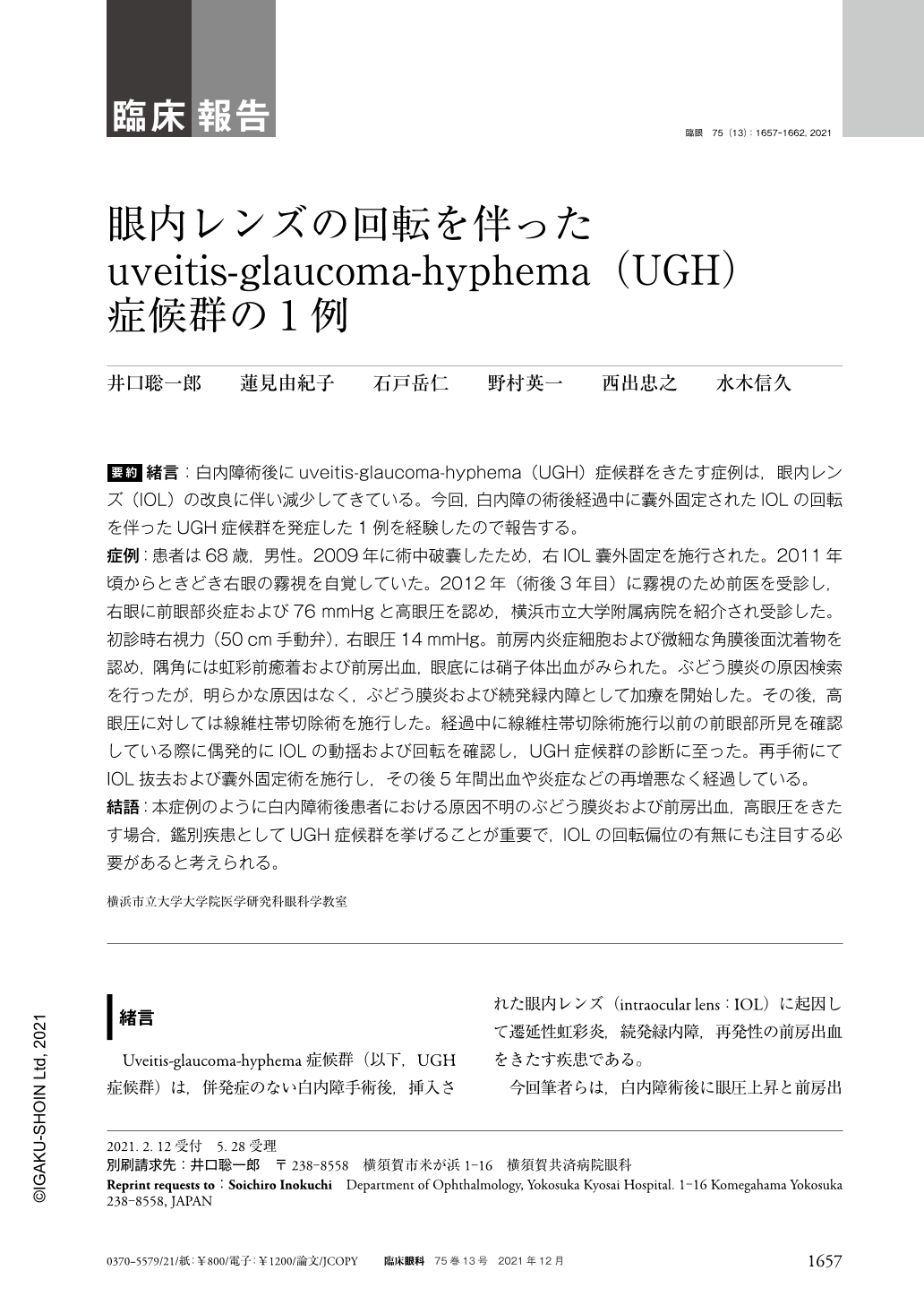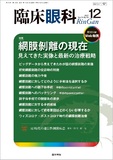Japanese
English
- 有料閲覧
- Abstract 文献概要
- 1ページ目 Look Inside
- 参考文献 Reference
要約 緒言:白内障術後にuveitis-glaucoma-hyphema(UGH)症候群をきたす症例は,眼内レンズ(IOL)の改良に伴い減少してきている。今回,白内障の術後経過中に囊外固定されたIOLの回転を伴ったUGH症候群を発症した1例を経験したので報告する。
症例:患者は68歳,男性。2009年に術中破囊したため,右IOL囊外固定を施行された。2011年頃からときどき右眼の霧視を自覚していた。2012年(術後3年目)に霧視のため前医を受診し,右眼に前眼部炎症および76mmHgと高眼圧を認め,横浜市立大学附属病院を紹介され受診した。初診時右視力(50cm手動弁),右眼圧14mmHg。前房内炎症細胞および微細な角膜後面沈着物を認め,隅角には虹彩前癒着および前房出血,眼底には硝子体出血がみられた。ぶどう膜炎の原因検索を行ったが,明らかな原因はなく,ぶどう膜炎および続発緑内障として加療を開始した。その後,高眼圧に対しては線維柱帯切除術を施行した。経過中に線維柱帯切除術施行以前の前眼部所見を確認している際に偶発的にIOLの動揺および回転を確認し,UGH症候群の診断に至った。再手術にてIOL抜去および囊外固定術を施行し,その後5年間出血や炎症などの再増悪なく経過している。
結語:本症例のように白内障術後患者における原因不明のぶどう膜炎および前房出血,高眼圧をきたす場合,鑑別疾患としてUGH症候群を挙げることが重要で,IOLの回転偏位の有無にも注目する必要があると考えられる。
Abstract Introduction:The number of cases of uveitis-glaucoma-hyphema(UGH)syndrome after surgery is on a decrease due to improvement in intraocular lenses(IOL). We report a case of UGH syndrome caused by rotation of the IOL fixed in the sulcus during the postoperative course of cataract.
Case:The patient was a 68-year-old man who underwent an operation of the right cataract with IOL implanted in the extracapsular in 2009. The patient presented with occasional blurred vision in the right eye since 2011. In 2012(third year after surgery), he visited his previous doctor for the recurrent blurred vision, and was referred to Yokohama City University Hospital for anterior segment inflammation and ocular hypertension of 76 mmHg in the right eye. Inflammatory cells and fine posterior corneal deposits were found in the anterior chamber, peripheral anterior synechia(PAS)and hyphema were found in the corner angle, and vitreoushemorrhage was found in the fundus. Ophthalmologic and physical examination revealed no obvious cause of uveitis, and treatment for uveitis and secondary glaucoma was started. Trabeculectomy was performed for ocular hypertension, and rotation of the intraocular lens was observed during the course of treatment, leading to the diagnosis of UGH syndrome. The patient underwent re-operation for the IOL removal and extracapsular fixation of another lens. The patient has not presented with any furtherexacerbation such as bleeding or inflammation for the past five years.
Conclusion:In the case of unexplained uveitis, hyphema, and ocular hypertention in postoperative cataract patients, as in this case, UGH syndrome should be mentioned as a differential diagnosis, and the presence of rotational deviation of the intraocular lens should also be noted.

Copyright © 2021, Igaku-Shoin Ltd. All rights reserved.


